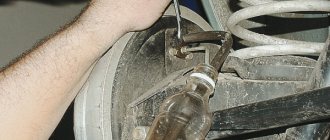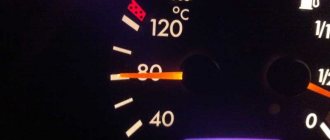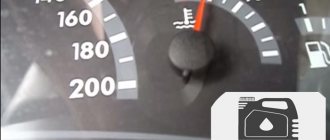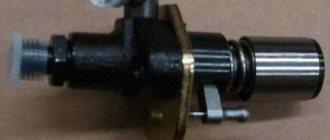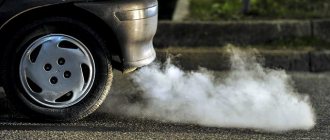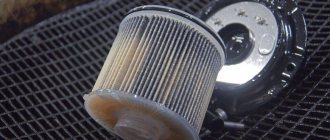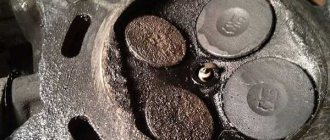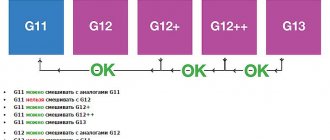A distinctive feature of a diesel engine from many gasoline analogues is the absence of an ignition system, since the mixture of fuel and air in the diesel cylinders ignites independently (from strong compression and heating). In this case, it becomes necessary to supply fuel to the combustion chamber under high pressure.
There are several types of diesel engine power systems, which differ in design and implementation, but the common thing is that each fuel system pumps fuel for subsequent injection of diesel fuel through diesel injectors.
It is quite obvious that for diesel engines, maximum tightness of the entire fuel system is extremely important. If air gets in, then the required injection pressure cannot be achieved. Moreover, excess air can damage expensive elements of the fuel supply system. Next, we will look at why and how to de-air the fuel system of a diesel engine.
Bleeding the injection system with high pressure fuel pump
A booster pump is installed on the high-pressure pump. It can work in manual mode.
First of all, it is necessary to pump fuel from the tank to the fine filter housing. To do this, you need to unscrew the fitting of the tube that connects the pump and the fine filter. From the filter side. If the pump is working properly, then the fuel is pumped quickly. If this doesn't happen. Then the butt works weakly and it will not be able to pump fuel further. In this case, it is necessary to raise the fuel level. Above the level of the fuel pump and filter housing. To do this, unscrew the tube from the fuel intake and extend it with a hose. Fuel is poured into the canister. It is suspended above the level of the injection pump and fine filters. Then the hose is lowered into it. The pump will now start working. When fuel appears from the unscrewed tube near the filter housing. It should be screwed back on.
Next, you need to bleed the cavity of the fuel filter housing. To do this, unscrew the fitting at the outlet of the filter housing. It takes a long time to download but there are no other options. As soon as fuel began to come out of the filter. Without air, tighten the fitting from the filter housing.
How to pump fuel if there is no pump
If the design of the car does not provide for a manual booster pump. As a rule, it is not available on passenger cars with fuel injection pumps. You have to turn the engine with the starter for a long time. And to reduce pumping time. It is necessary to unwind the tubes step by step. From the pump on the fuel pump. Then from the fine filter. So that air pockets do not interfere with the passage of fuel. A manually inflated hose is often used. They are drained of fuel from the tank. It creates pressure very well. It can also be used in conjunction with a booster pump. Its work is even more efficient than the built-in pump.
The fuel pump from the K 700 tractor is also very often used. It has a convenient lever and creates good pressure. It is even built into the tube coming from the tank. And they are installed permanently.
If the pump does not create a vacuum in the tube coming from the tank. It is possible that a crack has formed somewhere and there is an air leak. The crack is not big. And if there is fuel in the tube, it may not leak through it. Once the fuel is lost, the air is no longer able to create a vacuum because of it and the pump does not pump. In this case, all connections must be checked.
It is better, of course, to apply air pressure with a compressor. Into the tube from the pump to the tank. And in places where there are cracks, air bubbles will appear.
Fuel pumping in the Common Rail system
How to start a diesel engine if a common rail injection system is installed. Air from the tubes must be removed in stages. As a rule, such systems have a coarse fuel filter installed. The housing contains a booster pump. This is mainly done on trucks. If all the fuel has left the system, it will not be possible to pump fuel with this pump. It is also necessary to unscrew the tubes step by step up to the low pressure pump. And when the fuel fills the high pressure pump. The engine will not be able to start. Due to the presence of air in the high pressure system.
It is necessary to unscrew the tube that goes to at least one injector from the rail. And until fuel splashes out of it. Rotate the engine with the starter. Then you need to unscrew all the tubes going to the injectors, ideally. But 3-4 is a must. And as soon as fuel starts to appear from them. Screw it back. And try to start the engine. It is very difficult to start the engine if you just turn the engine with the starter. And pump it out. Very rarely this can lead to a positive result. Mostly only for the bad. The starter breaks. The high pressure pump plungers fail. It's better to spend some time. And gradually bleed the system. It will still be faster this way. No matter how hard you try to turn the starter, starting a diesel engine will not work. If air gets into the system. in any case it will have to be deleted.
Source
Remove the air lock from the Priora vehicle
Here's how it's done:
- the VAZ 2107 tank is checked to make sure there is fuel in it;
- the air release fitting on the fuel filter opens;
- Fuel is pumped up with a hand pump until fuel flows through the fitting without air bubbles;
- without stopping the pumping, close the air release fitting;
- Continue pumping until resistance is felt.
Now we need to try to start the engine. If this does not work, it means that air has entered the vehicle and must be expelled from there. On Priora it is done like this:
- the union nuts on the injection nozzles are loosened;
- the starter spins until the fuel comes out;
- Now the nuts are tightened and the engine can be started, as the air will escape along with the fuel.
In this way, the system of the Priora car is de-aired.
Hyundai HD 72 Hyundai HD 78
If for some reason you did not return back to the site and closed the payment system tab with a message about the successful completion of the payment, please let us know - we will send you a letter indicating access to download the book. The most common of them: The card has a restriction on paying for purchases on the Internet. A plastic card is not intended for making payments on the Internet.
The plastic card is not activated for making payments online. There are not enough funds for a plastic fuel system for Hyundai HD 72.
In order to solve these problems, you need to call or write to the technical support of the bank where you are served. Bank specialists will help you resolve them and make payments. That's basically it.
This ensures driver comfort while working. The cabin itself is mounted on rubber cushions, which improve shock-absorbing properties.
Steering column switches are a standard development of the Korean automobile industry. The one-piece design of the hydraulic booster and steering wheel of the Hyundai ND 72 ensures reliability, wear resistance and long service life.
Return to contents Brakes Elements of the braking system are installed of the drum type.
This ensures safety on icy roads, since the wheels are not completely blocked, but provide effective braking. This applies to service maintenance and replacement of parts.
Full maintenance is carried out after 1 km, and an oil change every 1 km. Hyundai HD Now it’s clear why it’s so important to prevent air from getting into the fuel line? How to remove remaining air from the entire fuel system?
Unfortunately, many people believe that by loosening the bleeder bolt on the booster pump, they will get rid of all their troubles. However, it's not. As a result of this operation, you simply fill the fuel filter with fuel, removing air from the tank to the fine filter inclusive.
Therefore, I would advise you to unscrew the fuel system of the Hyundai HD 72 not the bolt on the booster pump, but the return bolt on the injection pump itself. As a rule, on distribution injection pumps it is a 17 bolt with the inscription OUT, although other options are possible, for example, 19 bolts on Nissans or solenoid valves.
It is necessary to pump until diesel fuel runs out of the injection pump without air bubbles.
Common Rail fuel system (D4DD, D4GA): Replacement of HD78 injection pump
If bubbles are constantly coming from the return, you need to find a source of air leakage. Only by removing air from the injection pump can you be at least to some extent confident in the ability to start the engine, since the Hyundai hd 72 fuel system with a weak booster pump and plunger pair makes it extremely difficult to pump the fuel equipment by simply rotating the starter.
However, there are cases when it is impossible to pump fuel from the tank with a conventional booster pump, due to dirt getting under the valves or the valves not being tight.
The same is possible if there is no booster pump on some cars.
In this case, I will give you universal advice. Take a regular car tire pump, remove the return hose from the injection pump and try to pump air into it with the pump.
Thus, you will create excess pressure in the tank, which will pump fuel from the tank into the fine filter, and then fill the injection pump. It is only advisable that there is an adapter on the pump hose that fits tightly into the return hose. The main requirement for this Hyundai HD 72 fuel system is that the tank plug must be hermetically sealed, otherwise pressure will not be created.
To inflate the Hyundai HD 72 fuel system, you can use a compressor, but be careful not to inflate your tank. So, you have pumped up your injection pump, but your work on pumping the fuel system is not over. Do not forget that the high-pressure tubes that go from the injection pump to the injectors in the real Hyundai HD 72 fuel system are filled with air, which is easily compressed. Therefore, to simplify the procedure for starting the engine, which is especially important when the battery is weak or dead, unscrew the high-pressure pipes from the injectors.
Neither with a booster pump, nor even by pumping a compressor through the return line, you will not be able to pump the injection pump beyond the fittings, since they contain valves that open at a much higher pressure than the low-pressure fuel pump develops, and the system of channels in the plunger pair is such that does not allow fuel to penetrate directly through them into the high-pressure pipes in any position of the plunger when the engine is not running.
Thus, to fill the high-pressure pipes, you need to rotate the crankshaft with the starter or manually, but be sure to apply voltage to the fuel shut-off valve.
Source
With pump
Below is one way:
- It is necessary to loosen the fuel return bolt. As a rule, in most cases the bolt comes with a head size of 17. On foreign cars, the bolt is marked “out”;
- Under no circumstances should you think that the bolt does not come in other sizes. For example, on some Japanese cars it is 19. There may be a different size. For this reason, it is better to always use the instructions where all this is spelled out.
Let's continue:
- We study how the fuel flows. If we notice that there are bubbles in it, then this is it: air has entered the system;
- As a matter of fact, when the bubbles disappear, then the operation should be stopped;
- We take a regular car pump;
- Remove the hose from the diesel pump;
- We insert a hose from a car pump there;
- We pump it up a little to create pressure in the entire system. It will help pump diesel fuel and enter the pump;
- We will need an adapter that we connect to the return hose. In particular, you can even use a compressor.
Extremely
it's important not to overdo it
. The fuel tank can simply swell and this will not lead to anything good.
We further unscrew the remaining supply tubes. They go to the injectors. There could just be air left in them.
{banner_content}
Air congestion: signs and symptoms
Air entering the fuel line reduces the efficiency of the injectors, causing the following problems to occur:
It is quite simple to verify that the cause of such failures lies precisely in the entry of air into the fuel system. To do this, simply disconnect the high pressure pipes from the injector. Next, you will need a partner - he will rotate the crankshaft with an electric starter. If diesel fuel does not appear from the pipelines, it means that air has entered there. In this case, the diesel engine fuel system will need to be pumped.
But before you deal with the problem itself, it is necessary to identify and eliminate its cause.
Bleeding the brakes
When the engine is not running, we remove air from the system, first from one circuit and then from the other in the following sequence:
— brake mechanism of the right rear wheel;
— brake mechanism of the left front wheel;
— brake mechanism of the left rear wheel;
— brake mechanism of the right front wheel.
If air gets into one of the circuits, it is enough to bleed only this circuit, and not the entire hydraulic drive.
Before pumping, check the level of working fluid in the reservoir of the brake and clutch hydraulic drives and, if necessary, add fluid.
We clean the brake bleeder fitting of the right rear wheel from dirt and remove the protective cap from it (shown on a 4x4 vehicle).
Determining the location of air leaks
To determine the place where air is leaking into the fuel system of a diesel engine, it is necessary to carefully inspect the underbody of the car and its engine compartment. Diesel leaks, wet spots and cracks will be signs that the fuel line is damaged.
But sometimes there are no noticeable signs of air getting into the system. In this case, it is necessary to carry out a series of tests that will reveal the location of the damage.
You should start by checking the fuel line. To do this, you will need a container with a volume of 3-5 liters, two hoses about 60 cm long, diesel fuel and two clamps.
Important! All of the above elements must be clean, since even a small grain of sand getting into the engine can have a detrimental effect on its operation.
First you need to disconnect the fuel supply line and the return line. Hoses will be installed in their place (secured with clamps). With their free ends they are attached to a container into which fuel is poured. The container itself should be located above the injection pump.
The next step is to remove air from the fuel injection pump. There are several ways to do this, and they are all equally effective (the only option that is not acceptable here is cranking the crankshaft with a starter). Among them there are two that are the simplest and most accessible:
Now the car is left for several hours. If after this time the engine starts and runs normally, it means that there is indeed air in the fuel system of the diesel engine due to damage to the fuel line.
Next, you need to lower the container with diesel fuel significantly below the injection pump and again leave the car for several hours. If the engine starts and runs smoothly, it means that no air is entering through the pump. If problems are noticeable again, the problem is in the injection pump or in the return line.
To find out exactly where the breakdown occurred, it is necessary (after the engine has started) to clamp the tube connecting the “return” and the pump (on some models it is led not to the pump, but to the fuel filter - in this case, the problem with the return line is eliminated) .
The car is left again for a while. If there are no problems with its operation, it means that air is in the fuel system due to depressurization of the return fuel line. If problems occur again, the cause is the injection pump.
Important! There may be several places for suction, because used cars usually suffer from this problem. This means that the presence of several damaged parts at once cannot be ruled out.
How does air get into the vehicle?
ATTENTION! A completely simple way to reduce fuel consumption has been found! Don't believe me? An auto mechanic with 15 years of experience also didn’t believe it until he tried it. And now he saves 35,000 rubles a year on gasoline! Read more"
The vehicle of a modern car is a unit that stores and supplies fuel to the cylinders of the power unit. Most engines are designed so that the unit sucks in air, which is mixed at this time with the fuel injected into the vehicle, directly near the cylinders or directly into them (direct injection).
The first symptoms of air getting into the vehicle are associated with difficulties in starting the internal combustion engine. A system in which there is air can no longer function normally, which leads to difficulties.
Of course, a malfunction of the power unit itself is possible. Therefore, it is recommended to check the engine thoroughly first. If it does not start at all, then there is reason to believe that the problem lies with itself. However, if unstable operation is observed - normal startup, then a failure, then normal again, this is definitely air.
Another sign of air in the system is the response of the gas pedal. You press it, but it has no effect, because there is no air in the system, no fuel is supplied to the cylinders.
It is for this reason that, in order to test whether fuel is flowing into the cylinders, there is an exhaust test method. The driver must ask the assistant to hold the starter for about 40 seconds (provided that the car does not start). He himself must observe the exhaust to see if there is smoke coming from the muffler. If so, then fuel enters the cylinders and there is no air in the system. The reason for the difficult start must be sought elsewhere.
Air gets into the fuel line for various reasons. This mainly happens on used, old cars, the service life of which is more than three or five years.
The reason is that the seals responsible for the tightness of the entire system are aging. We are talking about clamps, connections, seals. There are plenty of them in the TS. In addition, the lines themselves through which fuel is supplied become obsolete, rust, and break over time. In a word, there is a whole series of circumstances that determine the failure of the fuel supply.
Of course, the designers provided something. If the seals become damaged, fuel begins to flow back into the tank. Some of the fuel remains in the pump, it is enough for the next engine start, no more.
Removing air from the diesel engine power system
When the point of air entry has been identified and all necessary measures have been taken to eliminate it, you can proceed directly to removing air from the system. To do this, you need to loosen the return line bolt again. After this procedure, there will still be air in the tubes going to the injectors.
Therefore, they should be unscrewed from the injector (it is enough to slightly loosen the fastening) and rotate the crankshaft. This can be done using a starter or manually. After fuel appears from the tubes, you can return them to their place. Bleeding can be done without unscrewing the tubes. But this is more difficult to do: you will have to spend much more effort and time.
Some motorists use another method of pumping the fuel system. To do this, you need to fill the fuel filter to the brim, start the engine and let it run at high speeds.
Basic information on the topic: replacement and performance diagnostics.
The clutch of the presented car brand does not have a specific validity period.
According to the rules, replacement of this car part must be carried out at the time of almost complete loss of performance. Almost all clutches of this brand of car are equipped with a hydraulic release bearing connected to the clutch cylinder. From our own experience, we can say that replacing this car part is usually accompanied by a leaking release bearing. Replacing the clutch of this brand of car is very different from the same action only on cars of another brand. This difference lies in the implementation of system bleeding after the clutch has been replaced. Pumping on the second Renault Megane model is carried out by connecting a special installation with a pump. If you have never encountered the system of bleeding and removing air from it, then even after replacement the clutch pedal will still remain in the floor.
Clutch Renault Megane 2
So, let's look at the signs of a malfunction of this part in a car:
- Loud noise is heard when turning on and off;
- when switched on it noticeably slips;
- during shutdown it leads noticeably;
- During operation, some jerks are felt.
If you have already noticed such signs in your car, then contact a car service as soon as possible to diagnose its performance. Do not delay this, because this may lead not only to replacing the clutch itself, but also to replacing the flywheel, and this service is more expensive.
It is also recommended to change the oil in the gearbox. It is recommended to completely change the entire list of parts and under no circumstances leave the old bearing, because it may start to leak.
Self-repair.
Replacing the clutch yourself:
- Place the front of the car on tripods;
- remove the front wheels;
- disconnect the clutch cord from the gearbox;
- remove the cord from the bracket;
- disconnect the speedometer cord from the gearbox;
- together with the steering knuckles, unscrew the bolts securing the ball joints;
- loosen the rear mounting of the left trailing arm;
- unscrew the bolts securing the left brace bracket;
- turn the lever 90⁰;
- if the ground is attached to the gearbox, it must be disconnected;
- unscrew the lower casing protecting the flywheel;
- unscrew the left engine support;
- unscrew the rear engine support from the body;
- unscrew the gear selector drive clamp;
- remove the gear selector drive;
- unscrew the engine from the gearbox;
- remove the gearbox;
- release the clutch;
- change the release bearing;
- using a special mandrel that centralizes the clutch discs, change the desired clutch disc;
- collect everything.
Bleeding the fuel system of a diesel engine
A distinctive feature of a diesel engine from many gasoline analogues is the absence of an ignition system, since the mixture of fuel and air in the diesel cylinders ignites independently (from strong compression and heating). In this case, it becomes necessary to supply fuel to the combustion chamber under high pressure.
It is quite obvious that for diesel engines, maximum tightness of the entire fuel system is extremely important. If air gets in, then the required injection pressure cannot be achieved. Moreover, excess air can damage expensive elements of the fuel supply system. Next, we will look at why and how to de-air the fuel system of a diesel engine.
Why is there a need to bleed the fuel system of a diesel engine and how to do it
As mentioned above, diesel fuel is supplied under high pressure. The specified pressure is created by the injection pump (high pressure fuel pump). If air leaks occur, the pressure in the pump does not reach the required values for effective fuel injection into the cylinders of a diesel engine.
Naturally, in such a situation, the diesel engine does not start well, operation at idle and under load may be unstable (diesel throttles), the speed begins to fluctuate, the power unit may stall while driving, etc. Note that not only airing manifests itself in the form of these symptoms, but it may also well be one of the causes.
Other methods of bleeding the fuel system of a diesel engine
So, above we looked at the main way to bleed a diesel fuel system. At the same time, many specialists and experienced car enthusiasts separately point out that in some cases such attempts to bleed the pump can have serious consequences for the power system.
Please note that the reason for this concern is that if there is mechanical damage, bleeding in this manner can cause irreparable damage. Let's look at other existing methods.
If so, you can use a simple tire inflator or compressor. Next, the hose is removed from the fuel pump and the air pump hose is installed in its place. The basic idea is that pumping occurs, which allows the pressure in the system to increase. This pressure makes it possible to pump diesel fuel into the fuel pump.
Having prepared the vacuum cleaner, you also need a regular medical syringe and a hose 30-40 cm long. For these purposes, it is recommended to use a transparent type of hose. The syringe is inserted into the hose, and the other end of the hose is put on the bleeder fitting.
Next, the piston is pulled out of the syringe, and the vacuum cleaner tube is inserted into the syringe. The main thing is to achieve reliable fixation and a tight fit. Also, the joints can be sealed by putting on pieces of hoses of different diameters, winding electrical tape, etc.
Now you can unscrew the fitting a little, after which the vacuum cleaner turns on. After a few seconds, yellowish foam can be seen in the syringe. This is a mixture of diesel fuel and air. Further pumping comes down to ensuring that the syringe is filled with clean diesel fuel instead of foam.
Let's consider another solution that allows, in some cases, to quickly pump the diesel fuel system. To do this, it is enough to completely fill the fuel filter housing with diesel fuel, after which the engine starts. Next, you need to let the engine run at high speeds, as a result of which the power system is pumped.
What's the result?
Taking into account the above information, it becomes clear that the stable operation of a diesel engine directly depends on the cleanliness of its fuel system. It is recommended to clean the injector on a diesel engine at least once every 12 months or every 25-30 thousand km. mileage (whichever comes first).
It must be taken into account that diesel fuel can heavily pollute the power system, even taking into account the fact that the fuel filter is regularly changed. At the same time, many problems can be avoided by installing additional fine filters that can trap even microscopic particles. Experts recommend installing such filters in the fuel line, as well as duplicating them in front of the injectors themselves.
If we talk about the method of cleaning with a solvent while the engine is running, this solution allows you to remove deposits on many engines and remove carbon deposits on both injectors and valves. However, this method cannot be a guarantee that the injectors themselves will be as efficient as possible.
In other words, cleaning injectors without removing them does not allow you to determine which injector may be faulty, what shape the spray pattern has, etc. It turns out that without removing the injectors from the engine and checking them on a bench, it is difficult to determine what is the main cause of malfunctions, dirt or mechanical damage.

